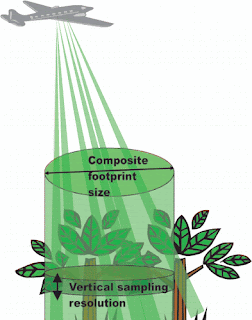http://www.jcronline.org.pinnacle.allenpress.com/doi/full/10.2112/SI53-010.1
One Line Summary
This study evaluates the capabilities of the Experimental Advanced Airborne Research LiDAR (EAARL) to predict the presence/absence of coastal vegetation communities in Barataria Preserve at Jean Lafitte National Park, Louisiana (JELA).
Short Summary
This study evaluates predictive vegetation models using LiDAR derived elevation (bare earth) and canopy height. Palaseany-Lovejoy et al. compared two modeling methods, parametric and non-parametric. General linear models and generalized additive models using conventional methods are both evaluated for the study area.
This study aims to model and predict presence/absence of vegetation communities, and to assess the statistical significance of observed relationships with lidar metrics. The objectives are to:
- model and predict presence/absence of coastal vegetation communities using EAARL lidar metrics as predictor variables in an area with small topographic variability.
- compare parametric and non-parametric methods of inference.
- assess modeling and prediction accuracies using conventional evaluation methods and two new indexes, net reclassification improvement (NRI) and integrated discrimination improvement (IDI).
Maps of vegetation communities and their spatial distribution are a primary tools in conservation, land management application, and decision support systems.
Several large scale efforts to map vegetation have used environmental gradients, in some cases combined with remote sensing data, to model and predict the presence/absence or percentage coverage of vegetation. (Bio, Alkemade, and Barendregt, 1998; Dobrowski et al., 2006; Frescino, Edwards, and Moisen, 2001; Moisen and Edwards, 1999; Moisen et al., 2006; Yee and Mitchell, 1991).
Relevant environmental gradients include elevation, slope, aspect, soil properties, water availability and subsurface depth, temperature, isolation, and latitude and longitude.
Remote sensing-based modeling and predictions are divided into two main groups: Parametric and non-parametric methods.
Parametric methods:
Positives: Have the benefits of ease to use. Easy to interpret, straightforward statistical properties, and use explicit regression equations.
Negatives: Based on the assumption of normal distribution.
Non-parametric methods
Positives: Do not require normal distribution, and can accommodate different distributions. These are data driven methods rather then model driven methods.
Lidar EAARL Vegetation Metrics
 |
| Definition of the EAARL Composite Footprint |
Four distinct metrics are derived from the continuous EAARL waveforms: bare earth (BE), canopy height (CH), canopy reflection ratio (CRR), and the height of median energy (HOME).
All four EAARL lidar-derived metrics were calculated in this study: bare earth, canopy height, canopy reflection ratio, and height of median energy.
Bare Earth - Represents the last return value.
Canopy height - is the distance from the composite-footprint first-return to the ground.
Canopy reflection ratio - is the sum of the waveform returns reflected off the canopy divided by the sum of all returns.
Height of Median Energy - is the median height of the entire composite waveform.
Evaluation Criteria
Models can be evaluated qualitatively or quantitatively in order to measure the degree of data fitting, or to assess the predictive power for real data or events (Myers, 1997).
Sensitivity is a measure of the proportion of true presence predicted by the model when the species actually occurred at that location and specificity is the proportion of absence predicted when true non-events or absence occurred (Cumming, 2000; Fielding and Bell, 1997).
Important Sources
Examples of generalized additive model (GAM) applications in modeling for plant ecology, mapping and prediction, forestry and ecological analyses have been presented by Austin (2002), Austin (2007), Austin et al. (2006), Frescino, Edwards, and Moisen (2001), Guisan, Edwards, and Hastie (2002), Leathwick, Elith, and Hastie (2006), Lehmann, Overton, and Leathwick (2002), Moisen et al. (2006), Wood and Augustin (2002), Yee and Mackenzie (2002), and Yee and Mitchell (1991).
| Bio, A. M. F. , R. Alkemade , and A. Barendregt . 1998. Determining alternative models for vegetation response analysis: a non-parametric approach. Journal of Vegetation Science 9 (1):5–16. |
| Dobrowski, S. Z. , J. A. Greenberg , C. M. Ramirez , and S. L. Ustin . 2006. Improving image derived vegetation maps with regression based distribution modeling. Ecological Modelling 192 (1–2):126–142. |
Myers, J. C. 1997. Geostatistical Error Management: Quantifying uncertainty for environmental sampling and mapping. New York Van Nostrand Reinhold. 571. p.
|
